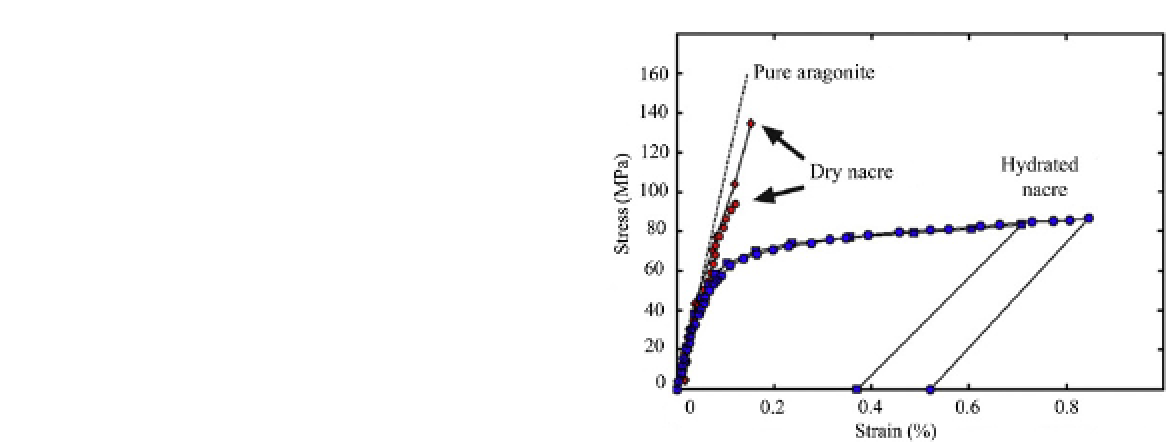Biomedical Engineering Reference
In-Depth Information
phases, and as such how they deform and fail
plays an important role in the overall behavior
of natural composites
[11-13]
. The roles of inter-
faces in natural composites include: (i) transfer-
ring stresses between inclusions; (ii) improving
the fracture resistance of materials containing
high amounts of brittle minerals
[14]
; (iii) acting
as bridges to connect two highly different mate-
rials through functionally graded properties,
exemplified by a gradient in mechanical proper-
ties along the muscle byssus connecting the soft
muscle to the hard substrate (e.g., a rock)
[15]
;
(iv) allowing large deformation and energy
dissipation
[16]
; and (v) acting as actuators that
can change shape or/and exert force upon the
application of a stimulus
[17]
.
The interfaces in natural composites are com-
posed of several different types of polymers that
provide a modular elongation that may convey
toughness to the material
[18]
. Interfaces in
nacre, for example, are composed of diverse
groups, mainly including
β
-chitin, glycine, and
alanine-rich proteins. Understanding the mech-
anisms associated with the interfaces in natural
composites is key to the improvement of biomi-
metic materials
[19, 20]
.
Nacre inspires many biomimetic studies
because: (i) its toughness is three orders of mag-
nitude higher than that of its main constituent,
(ii) it has less complex structure compared to
other biological materials, and (iii) its structure
is mainly optimized for mechanical functions
(protecting living organisms) rather than biologi-
cal functions (such as sensing, cell reproduction,
etc.). Nacre, a layered nanocomposite found in
mollusk shells, is composed of 95 %w/w of arag-
onite (a crystalline from of CaCO
3
) and 5 %w/w
of organic macromolecules. The aragonite layers
are about 0.5
μ
m thick and are bonded by
20-30 nm-thick organic layers
[18, 21]
. Hard bio-
logical composites, such as nacre, incorporate a
large amount of stiff mineral through a process
called
biomineralization
. In this process, minerals
nucleate and grow into pre-self-assembled
organic scaffolds
[19, 22]
.
FIGURE 3.2
Tensile stress-strain behavior of nacre.
Adapted from Ref.
14
.
The mineralization of these organic scaffolds
improves stiffness and compressive strength.
Figure 3.2
shows the tensile stress-strain behavior
of dry nacre, hydrated nacre, and pure arago-
nite. Dry nacre acts like monolithic aragonite
and fails in a brittle fashion at low levels of
strain (almost 0.1%). The response is linear elas-
tic with Young's modulus
E
∼
90 GPa. Hydrated
nacre, however, acts initially as a linear elastic
material (
E
∼
70 GPa) followed by a large inelas-
tic deformation before failure. Hydrated nacre
fails at almost 1% strain, which is high for a
material composed of 95 %w/w mineral. This
high level of strain is a result of progressive
spread of deformation through the material,
stemming from the structural properties of
nacre, i.e., tablet waviness
[14]
.
3.2 DESIGN GUIDELINES FOR
BIO
MIMETIC HARD MATERIA
LS
The remarkable performance of materials like
bone and nacre is due to their sophisticated
microstructure, in which high-aspect-ratio min-
eral tablets are bonded between layers of organic
materials and arranged in a brick-wall structure

